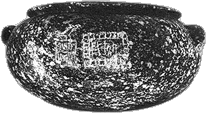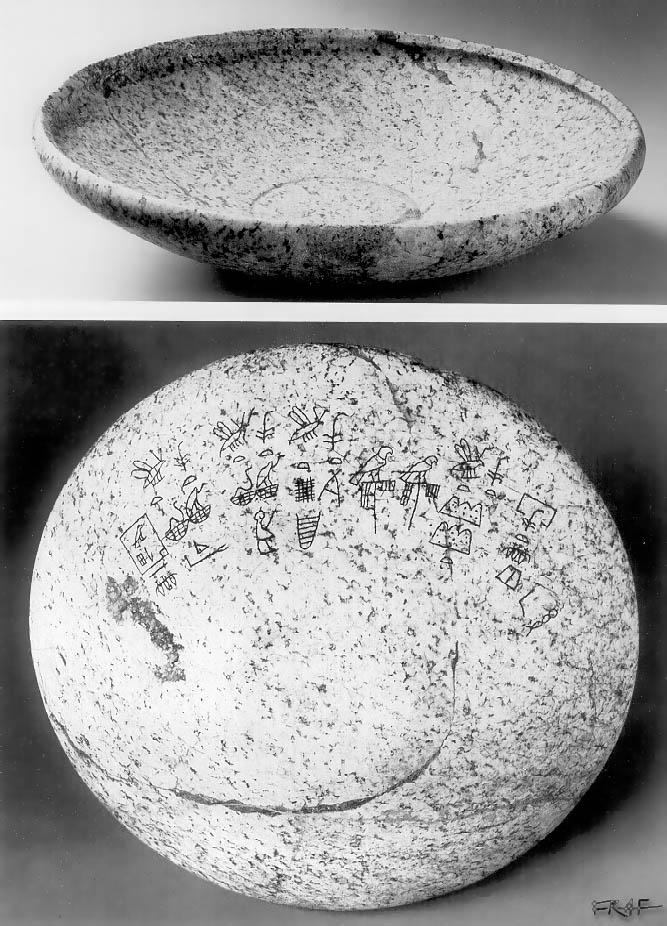|
Stone vessels are one of the most common kind of items
deposited (and found) in the Early Dynastic Royal and Private tombs.
They were produced since the earliest stages of the Naqada culture, but
the peak of the mastery in their fashioning was during the First Dynasty.
They continued to be produced after the Third Dynasty, but at definitely
lower levels of craftsmanship. Vessels are more often found smashed into fragments, only rarely are preserved in their integrity.
Most of the inscribed specimen have been found at Abydos Umm el-Qa'ab
(by E. Amelineau, W.M.F. Petrie) and Saqqara (Step Pyramid complex of
Netjerykhet and Sekhemkhet and North Saqqara tombs), but there are minor
amounts from a large number of Upper, Middle and Lower Egyptian cemeteries.
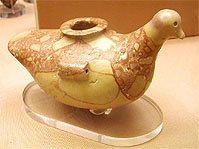 The
shape of the vessels varies to a good degree (cfr. A.J. Spencer, Archaic
Objects,1980, A. El Khouli,1978, 763ff.) and the range of production for
most of the forms is very broad; therefore it's hard to establish the
date of a certain vessel if we lack its context of discovery or an inscription
onto it; as Prof. A.J. Spencer notes in his introduction to the collection
of the British Museum "with unprovenanced material we are really
dating the type rather than the individual vessel"; and this date
is always something like 'First Dynasty', 'Late First Dynasty', when not
'First or Second Dynasty' ... the typological analysis of Ali
El Khouli (1978) is still the main tool available. No study has been devoted to the development and datation
of Early Dynastic stone vessels' shapes (but cf. now Aston, 1994; L.M. Mallory, Predynastic and First Dynasty Egyptian Basalt Vessels, PhD thesis,
University of Toronto 2000). These new studies and more which have been already programmed or started (as the analysis of the Brussels Museum material from Amelineau and Petrie's excavations of the Abydos, Umm el-Qaab royal tombs) will certainly add more data, both in the clearer definition of early typologies, and in the datation of the shapes according to the material used and the type of manufacture. The
shape of the vessels varies to a good degree (cfr. A.J. Spencer, Archaic
Objects,1980, A. El Khouli,1978, 763ff.) and the range of production for
most of the forms is very broad; therefore it's hard to establish the
date of a certain vessel if we lack its context of discovery or an inscription
onto it; as Prof. A.J. Spencer notes in his introduction to the collection
of the British Museum "with unprovenanced material we are really
dating the type rather than the individual vessel"; and this date
is always something like 'First Dynasty', 'Late First Dynasty', when not
'First or Second Dynasty' ... the typological analysis of Ali
El Khouli (1978) is still the main tool available. No study has been devoted to the development and datation
of Early Dynastic stone vessels' shapes (but cf. now Aston, 1994; L.M. Mallory, Predynastic and First Dynasty Egyptian Basalt Vessels, PhD thesis,
University of Toronto 2000). These new studies and more which have been already programmed or started (as the analysis of the Brussels Museum material from Amelineau and Petrie's excavations of the Abydos, Umm el-Qaab royal tombs) will certainly add more data, both in the clearer definition of early typologies, and in the datation of the shapes according to the material used and the type of manufacture.
Already since the Early Dynastic period, inscriptions do display a large
number of hieroglyphs which represent different forms of (stone) vessels
(see J. Kahl, Das System..., 1994, 790-822; I. Regulski, 2004).
.gif) What we are focusing onto here is the inscriptional evidence which characterizes
a part of these objects. Unfortunately El-Khouli's thesis didn't deal
with this aspect which hasn't been dealt with by anyone else to my knowledge
(contrarily see van den Brink's recent studies on Naqada IIIB-C1 pottery
incised serekhs). What we are focusing onto here is the inscriptional evidence which characterizes
a part of these objects. Unfortunately El-Khouli's thesis didn't deal
with this aspect which hasn't been dealt with by anyone else to my knowledge
(contrarily see van den Brink's recent studies on Naqada IIIB-C1 pottery
incised serekhs).
We know more or less 300 vessels (or fragments) with inscriptions of kings
of Dynasties I to III; they report names and titles of officials, mention
administrative, templar, funerary structures, royal palaces, sometimes
they record feasts and other very important celebrations (Kings' Heb Sed),
and, above all, they often have the royal name (Horus name or Nebty-Neswbity).
For this reason they have the same importance (and some similarities in
the inscriptional evidence) as the 1st Dynasty Labels (albeit this is particularly
true for vases with ink inscriotions rather than for those with incised ones).
Later bowls of the VIth Dynasty bear inscription fashioned with the year-sign
to the right side, as the Royal Annals; this is a feature which appeared,
before the late Old Kingdom, only on some pieces of Khasekhem from Hierakonpolis;
later similar (ink) inscriptions on stone vessels have been found in the
Step Pyr. complex (three, in P.D. V p. 88-90; Njnetjer's reign ?) and
at Elephantine (three, in Dreyer, FS Fecht 1987 p. 98-109 probably from
the reign of Huni - Njswteh), but despite their uncommonly longer text
than on the other vessels, they have no royal name.
The stone vessels inscriptions are made by incisions on the (generally
outer) surface of the vessel; very few examples are known which have been
carved in relief.
Incisions are often filled by a coloured paste which makes them show
up more visibly on the spotted or veined stone types.
Abundant are also the vessels inscribed in black or red ink (in this case
the inscription is often found inside the vessel): these form the large
corpus (Pyr.Deg. V) found at Saqqara, which Netjerykhet probably gathered
from the storerooms of the surrounding IInd Dynasty Royal Tombs. For Helck
(ZAS 106) these inscriptions in ink date to the reign of Ninetjer (as shown
by the recurrant name of Khnemwenii or Jj-n-Khnemw) and (the vessels)
may be still earlier. On palaeographic grounds, and also supported by the more probable later datation of the possible tomb of Ji-en-Khnum at Saqqara, 2498, I. Regulski (2004) has recently proposed that ink inscriptions could be from Khasekhemwy's time.
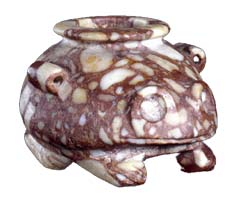 As
in later periods (New Kingdom), these objects were 'status markers', 'powerfacts',
because they could be owned only through a gift of the king to his most
valuable administrators. In the private tombs they had, aside the function
of containing the food/drinks offerings for the dead, also a value
by themselves (similar to the later Gold of Value which the general Djehwty
received from Thutmose III); some vessels are indeed 'dummy-vessels', i.e. they're
not hollow (especially frequent in the 2nd Dynasty), others have ornamental
forms inspired to animals (birds, frogs, fishes, pigs), plants (lotus,
water lily), objects (stands, tables, granaries, baskets, hieroglyphs-personal
names "Ankh-Ka",
and beautiful multifoiled circular bowls). Many shapes are also found on earlier slate palettes, thus vessels could also have a value as amulets, apotropaic items or cult images (temples' furniture). As
in later periods (New Kingdom), these objects were 'status markers', 'powerfacts',
because they could be owned only through a gift of the king to his most
valuable administrators. In the private tombs they had, aside the function
of containing the food/drinks offerings for the dead, also a value
by themselves (similar to the later Gold of Value which the general Djehwty
received from Thutmose III); some vessels are indeed 'dummy-vessels', i.e. they're
not hollow (especially frequent in the 2nd Dynasty), others have ornamental
forms inspired to animals (birds, frogs, fishes, pigs), plants (lotus,
water lily), objects (stands, tables, granaries, baskets, hieroglyphs-personal
names "Ankh-Ka",
and beautiful multifoiled circular bowls). Many shapes are also found on earlier slate palettes, thus vessels could also have a value as amulets, apotropaic items or cult images (temples' furniture).
The vessels of the galleries (VI-VII) beneath the pyramid of Netjerykhet
were not for food storage; they were neither sealed, and the only seal
impressions found in the galleries (Khasekhemwy and Netjerykhet himself)
were probably those impressed on the clay of the cords which had closed
the sacks containing the stone vessels collected from previous periods.
In the Early Dynastic period the inscribed stone vessels are rare
out of Egypt, (IInd dyn., Khasekhemwy at Byblos: Montet Kemi 1, 83ff)
in contrast with the abundance of pottery (Narmer); later, with the Vth
and especially the VIth Dynasty, there are a plenty of examples found
abroad, in Sudan (Pepi I,II, Kerma), Anatolia (at Dorak, Vth dyn.), and obviously
in the Southern Levant / Near East.
We have evidenced the value of these objects for the élite,
but what about the reason which made some early kings 'drag' their predecessors'
tombs' magazines to appropriate all of their vessels for their own tomb's
storerooms?
Was it only to reuse them for their food offerings without having to make
their craftsmen build more, or are there deeper and maybe magical/symbolical
reasons? (cf. Helck, ZAS 106, 1979; Lauer, Pyr. Deg. V, 1965, Conclusions). Similar usurpations occur for statuary and other artifacts.
Another similar practice to that of appropriating the vessels from past rulers' furniture, was to erase the royal name; this also encountered with statues. The practice is known from the end of the
Ist Dynasty (Adjib's vessels) up to the Second (Nebra); these vessels'
usurpations often made some scholars dub "unlegitimate rulers"
those kings who adopted this practice (Semerkhet), but it's an untenable
and old idea which can't be considered valid at all anymore.
The quantity of vessels grew in the second half of the Ist Dynasty with
the reign of Adjib; this is the king of whom the least number of labels
have been found (only 1, fragmentary). But the functions and the subjects
of the inscriptions on Stone Vessels, on labels and on cylinder seals
is, we must precise it, totally distinct, although some overlapping characters
are noticeable.
More than a dozen of examples give rows of royal names, the Neswt-bity
/ Nebty of Den, Adjib, Semerkhet and Qa'a: in this case, therefore, the
previous names have been retained and the successive rulers appropriate
the vessels but made them be inscribed beside, not over, the predecessors'
inscriptions (see W. Helck 'Untersuchungen zur Thinitenzeit' p.101; P.D.
n.19).
The quality of the vessels steadily increases with the early 1st Dynasty,
and the apex is perhaps the reign of Den. Afterwards there is a slow decay
up to the middle of the Second Dynasty (many roughly shaped dummy
vessels) although the reign of Khasekhemwy have left once again admirable
and, not seldom, unique shapes (little bowls closed by gold foils are
very fine artefacts).
A further particularity of interest about these objects is that in some
cases they have preserved names of previously unknown ephemeral rulers:
Sneferka, Bird, Za,
Nwbnefer; sometimes they are the
only contemporary source for kings otherwise unknown or attested in later documents only:
Wng, Sened (but for this latter's name on a brick inscr. from Saqqara
see his page).
After the end of the Second Dynasty the manufacture of stone vessels abruptly declined:
only one stone vessels (unprovenanced) is known bearing the name of Netjerykhet,
the king whom funerary complex yielded so many thousands fragments
of older kings' vessels.
We cannot be sure of the date of vessels which lack any inscription, but
it has been often expressed the idea that Djoser's sculptors must have
concentrated upon stone statues and architecture, therefore the stone
vessels' craftmanship would have declined in his reign (and he would eventually
reuse his predecessors' vessels).
It has never been made a specific study on the datation of the non-inscribed
stone vessels found in the Step Pyramid; Ali El-Khouli dated most of them
to the Third Dynasty. It must be said that Third Dynasty private tombs
like Saqqara 3073 (Khabausokar), 3518, 2405 (Hesyra) or Bet Khallaf K1
contained large amounts of stone vessels; but after this period there
is a sensibly decreased archaeological evidence (cf. Bet Khallaf K2, Zawiyet
el Aryan Z500) especially owing to those excavations which Firth, Quibell
and Emery made at North Saqqara in the last years of their respective
lives (see El-Khouli, op. cit., p. xi ff.) and which remained largely
unpublished.
For the remaining kings of the Third Dynasty the inscriptions on vessels
are not attested except for Khaba: on his
pieces the serekh and name have a particular carving (or hammering) technique;
they are all from Zawiyet el Aryan Layer Pyramid cem. (cfr. D. Dunham,
1978, Arkell J.E.A. 42, 44, N. Swelim, S.P., T. Wilkinson, E.D.E., Lehner
in 'Studies W.K.Simpson', tomb Z500) or unprovenanced.
As already cited, six 'annalistic' ink-inscriptions (three of Dyn. 2:
Ninetjer or, less probably, Khasekhemwy; three of Dyn. 3: perhaps Huni)
have been found (cfr. above); Sekhemkhet also used some vessels which
were destined to Ninetjer or Djoser (ink inscrip. of Jj-n-Khnemw); 700
vessels were found by Z. Goneim under Sekhemkhet's Pyramid, but only an
irrilevant number was adequately published.
With the Fourth Dynasty the inscriptions on stone vessels appeared again
and they became numerous once again under the Fifth and Sixth Dynasty
kings. The importance of these inscriptions, apart from the
means of chronological assistance, is in the details they reveal of the
complex system of the organization of the state through hundreds of named
structures, buildings, institutions and the name and titles of their principal
administrators, the place of the manufacture of the vessels (Hatnub and
other unidentified), marks of the workshops, the celebrations that the
vessels were fashioned and inscribed to commemorate (Heb Sed, 'Gotterfestungen'
and temples' opening, offerings to shrines, gods' festivals), the names
of phyles, of donors or receptors, and those of the establishments of
origin or destination of these gifts.
Apart from the royal and private names, a clue to the date of the vessels
-more precise than the shapes typology- can be obtained by the palaeographical
and epigraphical study of the inscriptions and by the arrangement of themselves
in vertical or horizontal lines (this latter orientation is extremely
rare before the reign of Horus Sekhemib).
The problem of forgeries (either fake inscriptions on original vessels
or forged uninscribed vessels) is an actual one (cf. Kaplony, Steingefasse). Finally some precisations on the Stone Vessels manufacture:
the stones used were more or less hard varieties, common or rare (few
vessels are known of flint, lapislazuli, obsidian); some were imported
from abroad, and almost all were extracted only by royal authorized expeditions.
The king had the monopoly on all the stages of the stone vessels production.
The commonest stones used were alabaster (calcite), limestone, schist
(slate/ greywacke), basalt, diorite, porphiry, marble, volcanic ash, then
crystal, breccia, serpentine, syenite, dolomite, granite, quartz and some
rerer ones. 
The raw block was initially pireced by a small tool which created the
hole to insert the drill. After the drill (and sand used as an abrasive agent) hollowed the vessel,
this latter was refined, carved and polished (El Khouli, op. cit., 789ff.).
The drill (Hmj; WB III, 82-6) was the hieroglyph (Gardiner signs U24-25)
to determine "crafts" ("art") and related words.
It was a wooden pole with a stone or two heavy bags tied on one end (to
augment by their weight the penetrative effect) and a stone or copper
point at the other end (often set in the crescent shaped extremity).
The use of "figure of eight shaped" drills, which was associated to the larger diffusion of tuff as a material for vessels late in the First Dynasty, led to qualitatively lower results (thicker walls or dummy vessels, largely widespread in the mid Second Dynasty). Cf. S. Bielen, in: Hendrickx et al. (eds.), Egypt at its Origins, 2004,621-35; S. Hendrickx, S. Bielen, P. de Paepe, in: MDAIK 57, 2001, 73-108). Predynastic and Early Dynastic vessels are present in most of the Egyptian Museums all over the World, but the (numerically) largest collections are those which share the ownership of the Abydos and the Memphite necropolis vessels and fragments threrof: the Cairo Museum and its basement, the Saqqara inspectorate, the Brussels RMAH and the Petrie Museum at University College, London (New York MMA, Philadelphia University Museum, Berlin Museuim, the Louvre, the Liverpool and the London British Museum also posses respectable collections).
For possible titles of sculptor and engraver of stone vessels: Weill 'Ire
Dynastie' p. 109-113, contra Helck cit. p. 258;
for stone vessels making: Denys A. Stocks in K. Bard ed. 'Encyclopedia
of the Archaeology of Ancient Egypt' 1999, 749-51; A. Lucas - J.R. Harris
'Ancient Egyptian Materials and Industries' 1962, p. 421 ff; Lucas, in:
JEA 16, 1930, p. 200-212; W. Emery, Archaic Egypt 1961, 214 ff; W. Needler,
Predynastic and Archaic Egypt in the Brooklyn Museum 1984, 238-9; see
also J. Spencer and J- Crowfoot-Payne catalogs and J. Vercoutter, in:
CdE 68, 1993, 77-80.
For some problems connected with Stone Vessels function and use cf. F. Raffaele, Stone Vessels in Early Dynastic Egypt, in: CCdE 7/8, 2005, 47-60. Stone vessels Corpus:
Ali el-Khouli, Egyptian Stone Vessels Predynastic period
to Dynasty III. Typology and analysis, Mainz am Rhein, 1978 (3 vols.)
B.G. Aston, Ancient Egyptian Stone Vessels. Materials and Forms. Heidelberg, 1994.
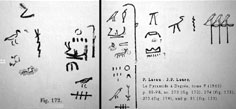 Corpus of Stone vessels inscriptions from Step Pyramid Complex
of Djoser, Saqqara: Corpus of Stone vessels inscriptions from Step Pyramid Complex
of Djoser, Saqqara:
P. Lacau - J.P. Lauer, La Pyramide à Degrés,
Tome IV, 1-2 (incised inscr.); Tome V (ink inscr.), Cairo 1959, 1961;
1965
Annalistic inscriptions (without royal names) on alabaster vessels (Second Dynasty):
ibid., tome V, 88-90 (nr. 172-174; see image on the right >);
cf. the beer jar inscriptions from Elephantine (late 3rd Dynasty):
G. Dreyer, Drei Archaisch-Hieratische Gefassaufschriften mit jahresnamen aus Elephantine, in: FS Fecht 1987, 98-109;
Kahl, Kloth, Zimmermann, Die Inschriften der 3. Dynastie, 1995, 168-171; M. Baud, Djéser et la IIIe dynastie, 2002, 56-59. Datation of the (ink) inscriptions on stone vessels from Saqqara SPC:
W. Helck, ZAS 106, 1979, 129 ff.
I. Regulski, Cracow 2002 International Conference. Origin of the State. Abstracts of Papers.
I. Regulski, Second Dynasty Ink Inscriptions from Saqqara... RMAH in Brussels, in: S. Hendrickx et al. (eds.), Egypt at its Origins, 2004, 949-970.
Museums:
To my knowledge the largest amount of Early Dynastic Egyptian
Stone vessels (with inscriptions) is found in the Cairo Museum (and in
its basement, as well as in the deposit of the North Saqqara inspectorate)
and in the Brussels Museum; there are large collections in other European
and US museums too. Private Collections:
P. Kaplony, Steingefasse mit Inschriften...., 1968
P. Kaplony, Beischriftete Kleinfunde, 1973 (Michailidis coll.) Web-links (stone vessels/stone working in Ancient Egypt):
http://nefertiti.iwebland.com/trades/stone_vessels.htm
http://www.digitalegypt.ucl.ac.uk/alphabet.html
http://www.petrie.ucl.ac.uk/ (search the collection for several examples)
http://www.geocities.com/unforbidden_geology/ancient_egyptian_stone_vase_making.html
http://www.geocities.com/unforbidden_geology/ancient_egyptian_copper_coring_drills.html
http://www.sunship.com/egypt/articles/stonetech.html |
